| کد مقاله | کد نشریه | سال انتشار | مقاله انگلیسی | نسخه تمام متن |
|---|---|---|---|---|
| 5515510 | 1541909 | 2017 | 9 صفحه PDF | دانلود رایگان |

- Ozone sensitivity in durum wheat is not necessarily linked to visible symptoms.
- Visible symptoms are due to localized oxidative burst around substomatal cavity.
- Localized oxidative burst is present in Colombo cv with lower ascorbate content.
- Stomata closure contributes to limit damages of photosynthetic tissue in Sculptur.
Colombo and Sculptur are two modern durum wheat cultivars that, in previous studies, proved to be very sensitive to ozone injury in terms of eco-physiological parameters and significant grain yield loss. Nevertheless, their response regarding leaf visible symptoms was very different; Sculptur showed almost no symptoms, even after several weeks of ozone exposure, whereas Colombo showed in a few weeks typical ozone-like symptoms (chlorotic/necrotic spots). The mechanisms underlying this different response has been studied with a biochemical and microscopical approach. Plants were grown in Open-Top Chambers (OTCs) and exposed to charcoal filtered and ozone enriched air. Flag leaves were analyzed at two phenological stages (pre- and post-anthesis). At pre-anthesis the ascorbate pool was significantly lower in Colombo, which also underwent an increase in the oxidized glutathione content and abundant H2O2 deposition in mesophyll cells around the substomatal chamber. No or scarce H2O2 was found at both phenological stages in ozone exposed leaf tissues of Sculptur, where stomata appeared often closed. In this cultivar, transmission electron microscopy showed that chloroplasts in apparently undamaged mesophyll cells were slightly swollen and presented numerous plastoglobuli, as a result of a mild oxidative stress. These results suggest that Sculptur leaves remains symptomless as a consequence of the higher content of constitutive ascorbate pool and the synergistic effect of stomata closure. Instead, Colombo shows chlorotic/necrotic symptoms because of the lower ROS (Reactive Oxygen Species) scavenging capacity and the less efficient stomata closure that lead to severe damages of groups of the mesophyll cells, however leaving the surrounding photosynthetic tissue functional.
480
Journal: Plant Physiology and Biochemistry - Volume 112, March 2017, Pages 261-269